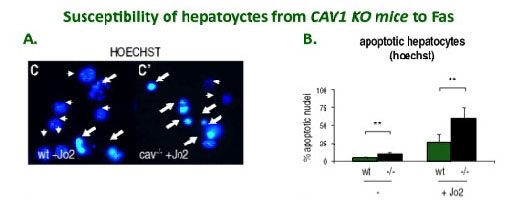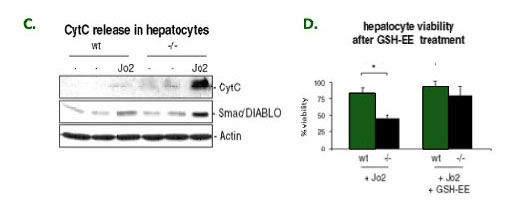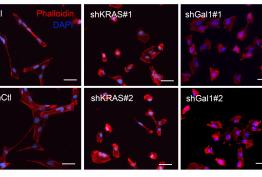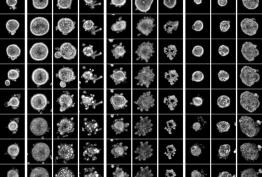Hepatocytes from wt and Cav-1 knockout mice exhibit enhanced susceptibility to Fas-mediated apoptosis and mitochondrial release of cytochrome c. GSH replenishment by GSH ethyl ester rescues Cav-1 deficient hepatocytes from Jo-2 induced apoptosis. Consequently, Cav-1 KO mice is more sensitive than wt mice to Fas-mediated steatohepatitis. For details please see Boch/Mari et al, Curr Biol 21: 681-686, 2011
www.ncbi.nlm.nih.gov/pubmed/21497090
Our recent work published on Current Biology: “Caveolin-1 deficiency causes cholesterol-dependent mitochondrial dysfunction and apoptotic susceptibility”, shows through in vivo and in vitro studies, an unconventional function of CAV-1. Caveolins are essential components of caveolae. The official life of caveolin-1 (CAV-1) resides on the plasma membrane as a scaffold protein organizing the activity of multiple signaling molecules in caveolae. CAV-1 exhibits binding properties towards fatty acids and cholesterol, and thus CAV-1 performs a moonlighting work regulating lipids homeostasis and trafficking. The lack of CAV-1 in humans and mice is associated with many pathologies, including cardiovascular diseases, lipodistrophy, diabetes, cancer and pulmonary fibrosis, but the underlying mechanisms for this widespread consequences are a mystery. In this study we characterize an unconventional function of CAV-1, namely regulation of mitochondria and metabolism. In the absence of CAV-1 mitochondria function is lost due to cholesterol accumulation which leads to impaired oxidative phosphorylation, reduced membrane dynamics and consequently crippled antioxidant defense due to GSH depletion. In conditions of high metabolic flux requiring energy production, the mitochondrial failure to meet the energetic demand results in high production of ROS causing cell death. The impact of these observations leads to mitochondrial-related diseases such as steatohepatitis and neurodegeneration. Full article published by Bosch M, Mari M et al, Current Biology 21: 681-686, 2011.








